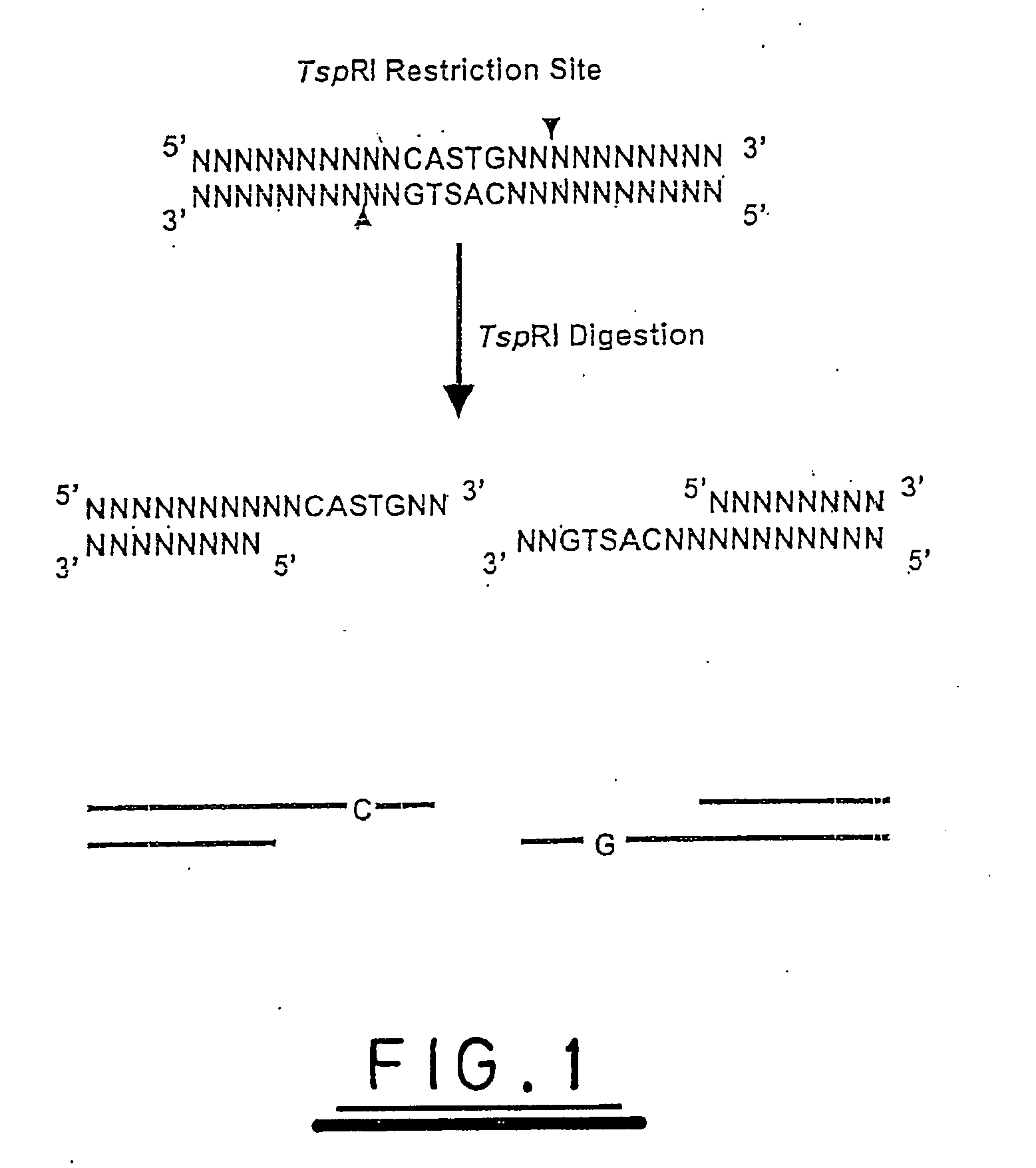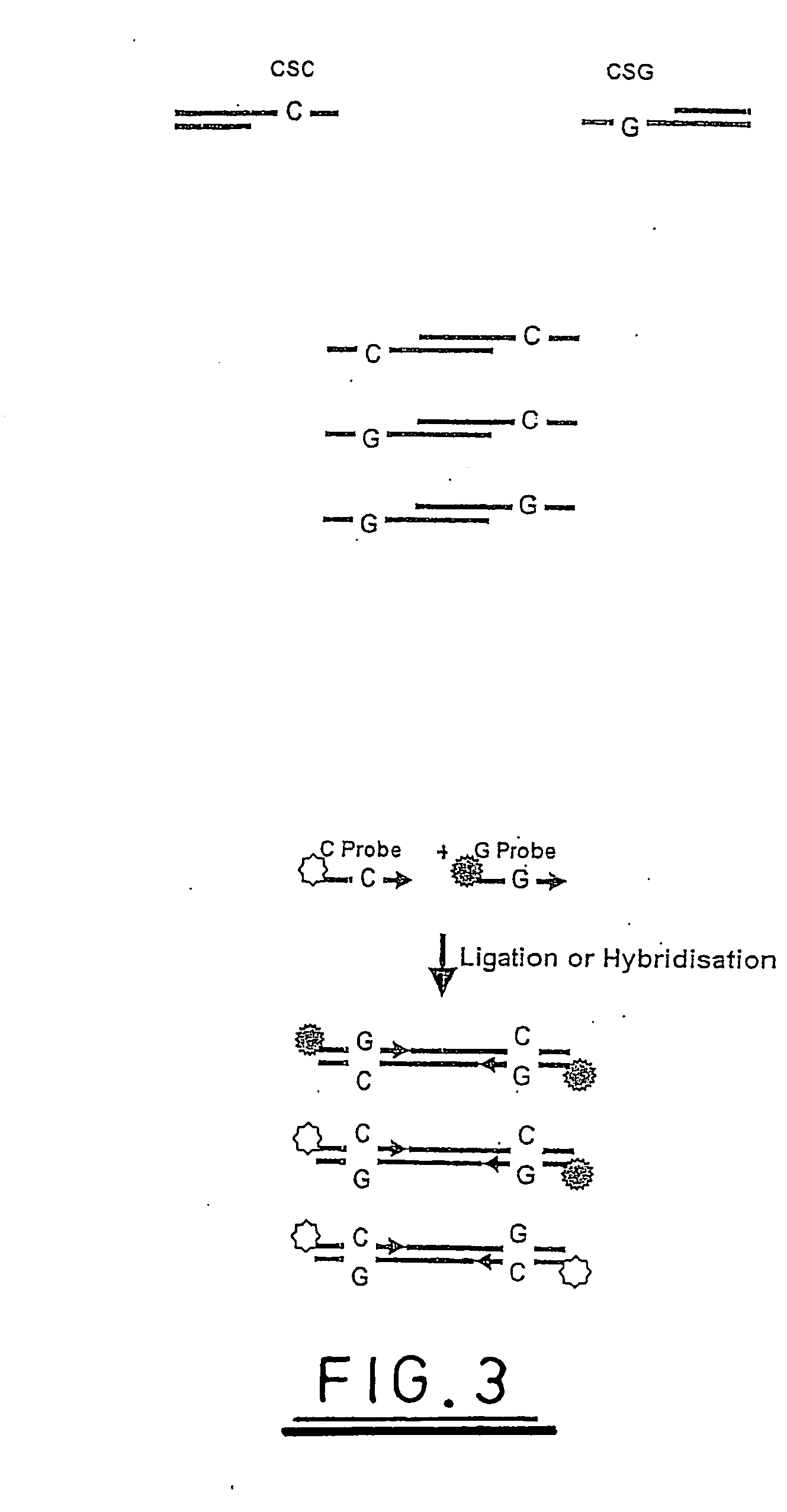Nucleic acid analysis
a nucleic acid and analysis technology, applied in the field of nucleic acid analysis, can solve the problems of long time-consuming techniques, and achieve the effect of high resolution and sufficient base specificity
- Summary
- Abstract
- Description
- Claims
- Application Information
AI Technical Summary
Problems solved by technology
Method used
Image
Examples
examples 1
Theoretical
[0111] A hypothetical analysis is illustrated with reference to the explanation supplied above and to FIGS. 6 to 10. Plasmid pUC19 is a double stranded circle of DNA, 2686 base pairs in length, whose sequence is fully known and, therefore, whose digestion with TspRI can be fully predicted.
[0112]FIG. 6 shows the sequence (upper strand only) at the expected restriction digestion sites for TspRI.
[0113]FIG. 7 shows the two overhanging 9 base sequences which would be present on each fragment generated by digestion with the enzyme and the predicted sequences that each would generate with the YR and KM pools of labelled oligonucleotides outlined above.
[0114] The disposition of these fragments following (hypothetical) agarose gel electrophoresis of is shown in FIG. 10. In practice it might be preferable to perform SW analysis in concert with the KM / RY analyses shown, however this is omitted from the figure to simplify the diagram in order to aid its understanding.
[0115]FIG. ...
example 2
[0118] The following experiment demonstrates the ligation of fluorescently tagged probes to TspRI restriction digest fragments of plasmid pUC19 and is illustrated with reference to the explanation supplied above and to FIGS. 6 to 12.
[0119] The following 9 base probes were synthesised
5′ JOE-NNCACTGNA-3′5′ FAM-NNCACTGNT-3′5′ ROX-NNCACTGNG-3′5′ TAMRA-NNCACTGNC-3′
[0120] JOE, FAM, ROX and TAMRA are fluorescent dye molecules known in the art, which can be distinguished on the basis of the wavelength at which fluorescent light is emitted from them. A probe mix was formulated containing 20 pmoles / μL of each probe. This is referred to as probe mix.
[0121] Plasmid pUC19 DNA (10 μL of 1 mg / μL solution.—New England Biolabs (NEB), catalogue number #304-1S) was digested with TspRI at 65° for 100 minutes in the following reaction mix;
PUC19 (1 mg / mL)10 μLNEB Buffer 4 (10x concentrate)10 μLBovine Serum albumen (20 mg / mL) 5 μLMolecular Biology grade water (MB water)70 μL
[0122] This was thoroughl...
PUM
| Property | Measurement | Unit |
|---|---|---|
| nucleic acid | aaaaa | aaaaa |
| relative size | aaaaa | aaaaa |
| sizes | aaaaa | aaaaa |
Abstract
Description
Claims
Application Information
 Login to View More
Login to View More - R&D
- Intellectual Property
- Life Sciences
- Materials
- Tech Scout
- Unparalleled Data Quality
- Higher Quality Content
- 60% Fewer Hallucinations
Browse by: Latest US Patents, China's latest patents, Technical Efficacy Thesaurus, Application Domain, Technology Topic, Popular Technical Reports.
© 2025 PatSnap. All rights reserved.Legal|Privacy policy|Modern Slavery Act Transparency Statement|Sitemap|About US| Contact US: help@patsnap.com



